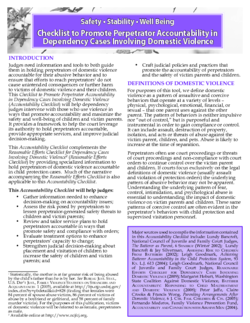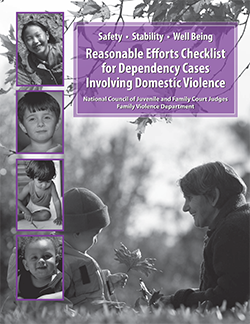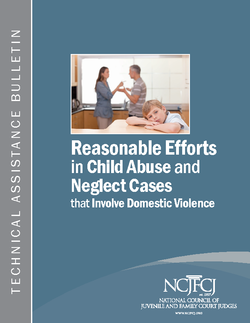National Child Abuse Prevention Month
Mao Yang, FVPSA Senior Program Specialist, Health and Human Services
Julie Fliss, Child Welfare Program Specialist, Office on Child Abuse and Neglect
Julie Fliss, Child Welfare Program Specialist, Office on Child Abuse and Neglect
The Family and Youth Services Bureau, Family Violence Prevention and Services Act (FVPSA) Program proudly funds the Resource Center on Domestic Violence: Child Protection and Custody (RCDV: CPC), a project of the National Council of Juvenile and Family Court Judges (NCJFCJ). RCDV:CPC works with judges, attorneys, court personnel, child welfare, and advocates to better understand domestic violence and child maltreatment better. It also promotes best practices to improve the safety and well-being of children and their non-abusing parent.
April is National Child Abuse Prevention Month (NCAPM), a time to recognize the importance of families and communities working together to prevent child abuse and neglect, and promote the social and emotional well-being of children and families. It also marks another opportunity to partner with our sister bureau, the Children’s Bureau (CB), which oversees NCAPM activities and federal efforts to increase awareness of this important issue.
Child abuse and neglect is a huge problem in the United States. The most recent child abuse and neglect data shows more than 674,000 children were victims of child abuse and neglect in fiscal year 2017.1 Efforts to support families and the primary prevention of child maltreatment is a top priority of CB. CB Associate Director Jerry Milner notes that, “right now, we typically respond only after families have lost much of their protective capacity and children have been harmed. We need to create environments where families get the support they need before harm occurs.” To achieve this, CB is 1) working with states to reorient child welfare agencies to focus on strengthening families through prevention at the community level, and 2) partnering with other federal agencies such as the Centers for Disease Control and Prevention and the Health Resources and Services Administration.
Likewise, domestic violence is another serious issue for our nation. About 1 in 4 women and 1 in 10 men experience domestic violence during their lifetime.2 In fact, child abuse and domestic violence often overlap.3 For example, domestic violence was a risk factor for 27% of the 426,000 child victims whose cases were substantiated.4 In many instances, children are used as a way to control and manipulate another parent. Children may be victims of abuse themselves. And they may witness or be exposed to the violence. Domestic violence can affect children in many ways, depending on the individual child’s response to trauma. Children may become withdrawn or act out. They may develop health conditions or illnesses. They may have developmental delays. Others may be unable to regulate their emotions or connect with others socially.5
Fortunately, one of the most effective ways to reduce the negative effects of this type of trauma is to support and strengthen their bond with their nonabusive parent. In order to do this, we should focus on the parent-child unit. Children play a big role in the abused parent’s decision to stay or leave an abusive relationship. Victims often weigh the pros (having support of the other parent, source of income, stable housing, cultural expectations, etc.) with cons (abuse, fear, shame, loss of the other parent’s support, homelessness, economic insecurity, etc.). It is critical to support victims in planning for the safety of their children and themselves. In addition, we should empower them with knowledge, information, and resources so they can improve the health and well-being of their families.
Let’s take it one step further by focusing on the entire family as a unit. Many victims just want the abuse to end. Many abusers want to be better parents. Abusers can change. They can become nonviolent parents and partners. Engaging with parents who use violence, holding them accountable for the abuse, and connecting them with responsible fatherhood, parenting, and batterers intervention programs are key. Similar to victims, we should also empower abusive parents with skills, knowledge, and resources to improve the health and well-being of their families. Although no one system can do this work alone, together courts, child welfare, and domestic violence providers can help support families’ paths to healing.
Making reasonable efforts to keep families safe and together is critical to improving outcomes for children and their abused parents. “Making reasonable efforts to do so is not just best practice, it’s the law,” according to Judge Michael Key, of Troup County Juvenile Court in Georgia, who provides trainings through NCJFCJ. Reasonable efforts means connecting families to domestic violence services, batterers intervention programs, and other services. It means making sure children have opportunities to increase resiliency and strengthen their bond with their non-abusing parent. By connecting the family to supportive services and intervention programs, courts, child protection, and domestic violence advocates can help to increase protective factors for children and eliminate risk factors like domestic violence. Collaboration between all entities is needed to make sure connections can be made.
This year, NCJFCJ celebrates the 20th anniversary of the Greenbook Project, which initiated and supported collaborations across systems to work towards better outcomes for families experiencing domestic violence that are involved with child welfare. Congratulations NCJFCJ, Greenbook sites, and all communities that recognize the overlap and continue to work at the intersection of domestic violence and child abuse and neglect! Building on lessons learned from the Greenbook Project, CB partnered with Futures Without Violence to implement the Quality Improvement Center on Domestic Violence in Child Welfare (QIC-DVCW). The purpose of the QIC-DVCW is to build knowledge of effective collaborative approaches and practices that produce positive outcomes for children and families involved with child welfare and experiencing domestic violence.
On April 24-26, CB will host the 21st National Conference on Child Abuse and Neglect (NCCAN) in Washington, DC. The theme of this year’s conference is “strong and thriving families”. The event will bring together more than 1,400 child welfare staff, child maltreatment prevention partners, parents, and community members from around the country. Workshops, skills seminars, and poster presentations are just a few of the session formats that will be featured during the 3-day event. We truly hope the conference will create and foster a positive and lasting partnerships and have an impact across the country towards making the vision of strong and thriving families a reality. If you are interested in attending NCCAN, please do not hesitate to register. We anticipate a waitlist for this event.
Moreover, when we work together, and join our ideas and creative energies, we can create safe, stable and nurturing environments where children and families thrive. The Children's Bureau's information service, Child Welfare Information Gateway, offers several resources related to preventing child abuse, protecting children from the risk of abuse, and promoting healthy families through the National Child Abuse Prevention Month website. In addition, Futures Without Violence, FVPSA’s technical assistance provider on children and youth impacted by domestic violence, offers statistics, resources, and interventions to address the effects of domestic violence and trauma on children and youth.
For more information on NCAP Month activities and resources, as well as ways that you can get involved in raising awareness, please visit: https://www.childwelfare.gov/topics/preventing/preventionmonth/.
Download Blog as PDF
_____________________________
1 U.S. Department of Health and Human Services, Administration for Children and Families, Administration on Children, Youth and Families, Children’s Bureau. (2019). Child Maltreatment 2017. Available from https://www.acf.hhs.gov/cb/research-data-technology/statistics-research/child-maltreatment.
2 Smith, S.G., Zhang, X., Basile, K.C., Merrick, M.T., Wang, J., Kresnow, M., Chen, J. (2018). The National Intimate Partner and Sexual Violence Survey (NISVS): 2015 Data Brief – Updated Release. Atlanta, GA: National Center for Injury Prevention and Control, Centers for Disease Control and Prevention.
3 https://www.rcdvcpc.org/co-occurrence-of-child-abuse-and-domestic-violence-exposure.html.
4 U.S. Department of Health & Human Services, Administration for Children and Families, Administration on Children, Youth and Families, Children’s Bureau. (2019). Child Maltreatment 2017. Available from https://www.acf.hhs.gov/cb/research-data-technology/statistics-research/child-maltreatment.
5 http://promising.futureswithoutviolence.org/what-do-kids-need/get-the-facts/effects-of-domestic-violence/
April is National Child Abuse Prevention Month (NCAPM), a time to recognize the importance of families and communities working together to prevent child abuse and neglect, and promote the social and emotional well-being of children and families. It also marks another opportunity to partner with our sister bureau, the Children’s Bureau (CB), which oversees NCAPM activities and federal efforts to increase awareness of this important issue.
Child abuse and neglect is a huge problem in the United States. The most recent child abuse and neglect data shows more than 674,000 children were victims of child abuse and neglect in fiscal year 2017.1 Efforts to support families and the primary prevention of child maltreatment is a top priority of CB. CB Associate Director Jerry Milner notes that, “right now, we typically respond only after families have lost much of their protective capacity and children have been harmed. We need to create environments where families get the support they need before harm occurs.” To achieve this, CB is 1) working with states to reorient child welfare agencies to focus on strengthening families through prevention at the community level, and 2) partnering with other federal agencies such as the Centers for Disease Control and Prevention and the Health Resources and Services Administration.
Likewise, domestic violence is another serious issue for our nation. About 1 in 4 women and 1 in 10 men experience domestic violence during their lifetime.2 In fact, child abuse and domestic violence often overlap.3 For example, domestic violence was a risk factor for 27% of the 426,000 child victims whose cases were substantiated.4 In many instances, children are used as a way to control and manipulate another parent. Children may be victims of abuse themselves. And they may witness or be exposed to the violence. Domestic violence can affect children in many ways, depending on the individual child’s response to trauma. Children may become withdrawn or act out. They may develop health conditions or illnesses. They may have developmental delays. Others may be unable to regulate their emotions or connect with others socially.5
Fortunately, one of the most effective ways to reduce the negative effects of this type of trauma is to support and strengthen their bond with their nonabusive parent. In order to do this, we should focus on the parent-child unit. Children play a big role in the abused parent’s decision to stay or leave an abusive relationship. Victims often weigh the pros (having support of the other parent, source of income, stable housing, cultural expectations, etc.) with cons (abuse, fear, shame, loss of the other parent’s support, homelessness, economic insecurity, etc.). It is critical to support victims in planning for the safety of their children and themselves. In addition, we should empower them with knowledge, information, and resources so they can improve the health and well-being of their families.
Let’s take it one step further by focusing on the entire family as a unit. Many victims just want the abuse to end. Many abusers want to be better parents. Abusers can change. They can become nonviolent parents and partners. Engaging with parents who use violence, holding them accountable for the abuse, and connecting them with responsible fatherhood, parenting, and batterers intervention programs are key. Similar to victims, we should also empower abusive parents with skills, knowledge, and resources to improve the health and well-being of their families. Although no one system can do this work alone, together courts, child welfare, and domestic violence providers can help support families’ paths to healing.
Making reasonable efforts to keep families safe and together is critical to improving outcomes for children and their abused parents. “Making reasonable efforts to do so is not just best practice, it’s the law,” according to Judge Michael Key, of Troup County Juvenile Court in Georgia, who provides trainings through NCJFCJ. Reasonable efforts means connecting families to domestic violence services, batterers intervention programs, and other services. It means making sure children have opportunities to increase resiliency and strengthen their bond with their non-abusing parent. By connecting the family to supportive services and intervention programs, courts, child protection, and domestic violence advocates can help to increase protective factors for children and eliminate risk factors like domestic violence. Collaboration between all entities is needed to make sure connections can be made.
This year, NCJFCJ celebrates the 20th anniversary of the Greenbook Project, which initiated and supported collaborations across systems to work towards better outcomes for families experiencing domestic violence that are involved with child welfare. Congratulations NCJFCJ, Greenbook sites, and all communities that recognize the overlap and continue to work at the intersection of domestic violence and child abuse and neglect! Building on lessons learned from the Greenbook Project, CB partnered with Futures Without Violence to implement the Quality Improvement Center on Domestic Violence in Child Welfare (QIC-DVCW). The purpose of the QIC-DVCW is to build knowledge of effective collaborative approaches and practices that produce positive outcomes for children and families involved with child welfare and experiencing domestic violence.
On April 24-26, CB will host the 21st National Conference on Child Abuse and Neglect (NCCAN) in Washington, DC. The theme of this year’s conference is “strong and thriving families”. The event will bring together more than 1,400 child welfare staff, child maltreatment prevention partners, parents, and community members from around the country. Workshops, skills seminars, and poster presentations are just a few of the session formats that will be featured during the 3-day event. We truly hope the conference will create and foster a positive and lasting partnerships and have an impact across the country towards making the vision of strong and thriving families a reality. If you are interested in attending NCCAN, please do not hesitate to register. We anticipate a waitlist for this event.
Moreover, when we work together, and join our ideas and creative energies, we can create safe, stable and nurturing environments where children and families thrive. The Children's Bureau's information service, Child Welfare Information Gateway, offers several resources related to preventing child abuse, protecting children from the risk of abuse, and promoting healthy families through the National Child Abuse Prevention Month website. In addition, Futures Without Violence, FVPSA’s technical assistance provider on children and youth impacted by domestic violence, offers statistics, resources, and interventions to address the effects of domestic violence and trauma on children and youth.
For more information on NCAP Month activities and resources, as well as ways that you can get involved in raising awareness, please visit: https://www.childwelfare.gov/topics/preventing/preventionmonth/.
Download Blog as PDF
_____________________________
1 U.S. Department of Health and Human Services, Administration for Children and Families, Administration on Children, Youth and Families, Children’s Bureau. (2019). Child Maltreatment 2017. Available from https://www.acf.hhs.gov/cb/research-data-technology/statistics-research/child-maltreatment.
2 Smith, S.G., Zhang, X., Basile, K.C., Merrick, M.T., Wang, J., Kresnow, M., Chen, J. (2018). The National Intimate Partner and Sexual Violence Survey (NISVS): 2015 Data Brief – Updated Release. Atlanta, GA: National Center for Injury Prevention and Control, Centers for Disease Control and Prevention.
3 https://www.rcdvcpc.org/co-occurrence-of-child-abuse-and-domestic-violence-exposure.html.
4 U.S. Department of Health & Human Services, Administration for Children and Families, Administration on Children, Youth and Families, Children’s Bureau. (2019). Child Maltreatment 2017. Available from https://www.acf.hhs.gov/cb/research-data-technology/statistics-research/child-maltreatment.
5 http://promising.futureswithoutviolence.org/what-do-kids-need/get-the-facts/effects-of-domestic-violence/



